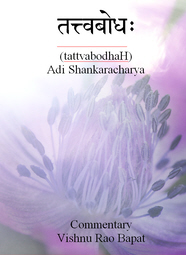
VEDĀNTA the solution to our fundamental problem by D. Venugopal
Part 53 explains why stopping thoughts or destroying the mind has nothing to do with enlightenment.
There is a complete Contents List, to which links are added as each new part appears.


VEDĀNTA the solution to our fundamental problem by D. Venugopal
Part 53 explains why stopping thoughts or destroying the mind has nothing to do with enlightenment.
There is a complete Contents List, to which links are added as each new part appears.

VEDĀNTA the solution to our fundamental problem by D. Venugopal
Part 52 asks whether branches of yoga other than j~nAna are able to confer mokSha and refers to the categorization given in the Bhagavad Gita.
There is a complete Contents List, to which links are added as each new part appears.

VEDĀNTA the solution to our fundamental problem by D. Venugopal
Part 51 explains the roles of action and knowledge in attaining mokSha. Shankara provides the reasoning why the function of karma is to purify the mind while j~nAna removes the ignorance that prevents the realization that we are already free.
There is a complete Contents List, to which links are added as each new part appears.

VEDĀNTA the solution to our fundamental problem by D. Venugopal
Part 50 explains the concept of sarvAtmabhAva – how upAdhi-s account for the apparent existence of many, even though there is only AtmA. And it explains how we can know ‘I’ as AtmA whilest still acting as an individual jIva.
There is a complete Contents List, to which links are added as each new part appe

VEDĀNTA the solution to our fundamental problem by D. Venugopal
Part 49 explains how the mahAvAkya ‘tat tvam asi‘ produces knowledge of brahman via the akhaNDAkAra vRRitti in the mind.
There is a complete Contents List, to which links are added as each new part appears.

VEDĀNTA the solution to our fundamental problem by D. Venugopal
Part 48 concludes the explanation of the mahAvAkya ‘tat tvam asi‘ by a detailed analysis of the mechanism by which the contradictory mithyA aspects of Ishvara and jIva are given up, leaving the satyam oneness of brahman.
There is a complete Contents List, to which links are added as each new part appears.

VEDĀNTA the solution to our fundamental problem by D. Venugopal
Part 47 begins the explanation of the mahAvAkya ‘tat tvam asi‘. It first deals with the ‘direct’ (vAchyArtha) meaning. The 3 indicators (lakShaNA-s) for deriving the implied or intended meaning (lakShyArtha) of a word are then examined.
There is a complete Contents List, to which links are added as each new part appears.

VEDĀNTA the solution to our fundamental problem by D. Venugopal
Part 46 explains the six ‘indicators’ (ñaò-tätparya-liìgas) used by the Upanishads to convey the meaning of their topics.
There is a complete Contents List, to which links are added as each new part appears.

Part 31 of the commentary by Dr. VIshnu Bapat on Shankara’s Tattvabodha.This is a key work which introduces all of the key concepts of Advaita in a systematic manner.
The commentary is based upon those by several other authors, together with the audio lectures of Swami Paramarthananda. It includes word-by-word breakdown of the Sanskrit shloka-s so should be of interest to everyone, from complete beginners to advanced students.
Part 31 provides the bare Sanskrit shlokas in Devanagari script and concludes this series.
There is a hyperlinked Contents List, which is updated as each new part is published.